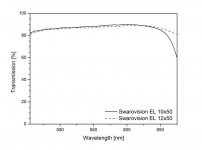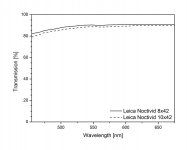Scarletmacawdad
Well-known member
Friends,
I was birding an open marshland today after the rain cleared. I had waders and duck like birds behind me and an energetic harrier hunting.
I brought my new SV 12x50 and my Leica 10x42.
Time was 2-3 hours before sunset. Dimming, but not dark.
QUESTION: I can see how handshake interferes with grabbing fine detail, such as the striations in the wings of the harrier, such that the Leica at 10 outperforms the SV at 10.
PUZZLE: why was the SV also dimmer?
They have comparable exit pupils ~4mm, but I must be missing some math here.
(I should indicate I am 40, but my eyes make it to 4mm)
At twighlight, there is no comparison between the two. The 12's rule hands down.
But I was saddened I could not depend on my SV 12's for the most pleasing view during the day. They appeared dimmer and less life like.
I am sure I am missing math. I throw my ignorance upon the mercy of the collective wisdom of this group.
I was birding an open marshland today after the rain cleared. I had waders and duck like birds behind me and an energetic harrier hunting.
I brought my new SV 12x50 and my Leica 10x42.
Time was 2-3 hours before sunset. Dimming, but not dark.
QUESTION: I can see how handshake interferes with grabbing fine detail, such as the striations in the wings of the harrier, such that the Leica at 10 outperforms the SV at 10.
PUZZLE: why was the SV also dimmer?
They have comparable exit pupils ~4mm, but I must be missing some math here.
(I should indicate I am 40, but my eyes make it to 4mm)
At twighlight, there is no comparison between the two. The 12's rule hands down.
But I was saddened I could not depend on my SV 12's for the most pleasing view during the day. They appeared dimmer and less life like.
I am sure I am missing math. I throw my ignorance upon the mercy of the collective wisdom of this group.






